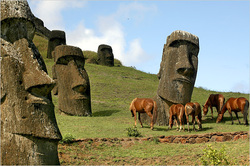 Tomas Munita for The New York Times Tomas Munita for The New York Times by Daniel Schnitzer Let me tell you a story. It is one that is known to few, but to those who know it, has had a lasting impact on the way they think about society and the environment. It is the story of a long-forgotten civilization, which at its pinnacle was never known to the outside world. It is the story of the people of Easter Island – the Rapanui – who named their island Te Pito Te Henua – “the navel of the world.” That name implies a deep connection to life. It speaks to the lushness and diversity of the flora and fauna that the mythical first king, Hotu Matua, and his subjects discovered, like some providential land out of a dream. The first Rapanui were blessed with abundant natural resources – porpoise, fish, birds and rat were primary foodstuffs, and some 21 species of now vanished plants and trees were used for canoes, rafts, rope, cloth, harpoons, firewood and construction. But Easter Island is not famous for its trees. It is known throughout the world for its monolithic statues, called moai, and the numinous intelligence they seem to project. We know now that the moai were a manifestation of religious beliefs and peaceful competition amongst clans on the island, whose chiefs strove to outdo the grandeur of each other’s moai and ceremonies. While they realized that the resources of one clan were vital to the survival of the others (for example, one clan claimed the two best harbors in its territory, while another’s domain included the best stone quarry), they failed to appreciate the fragility of the island they called home. Throughout much of the island, trees had been cleared for garden plots, which lead to less than ideal conditions for trees to re-grow. The trees were then being used for the transport of moai, and to cremate the bodies of the dead, a sacred tradition that had been practiced for centuries, and which consumed massive amounts of wood. As it became all too clear that their once bountiful island was moving inexorably towards desolation, the Rapanui urgently invoked their ancestors by devoting more and more resources to erect ever-larger moai. Without the diverse and abundant source of trees and native plants they once enjoyed, the Rapanui were no longer able to make robust canoes and rafts capable of taking them far out into the ocean to hunt tuna and porpoise. Instead, they were forced to turn to small crustaceans and a limited population of birds. In a few generations, these food supplies dwindled as well, hurling the Rapanui into a civil war that overthrew the reigning chiefs and saw the tearing down of every last moai on the island. The Easter Islanders had nowhere to go after it had become all too painfully obvious they had ruined themselves. Their descent into cannibalism shortly before the outbreak of civil war is a stark reminder of the vital connection between the environment and our humanity.
0 Comments
Your comment will be posted after it is approved.
Leave a Reply. |
EarthSpark supporters make our work possible. Thank you for considering a donation towards eliminating energy poverty in Haiti.
Read the full blog - click here!
|
EarthSpark International is a non-profit 501(c)3 organization.
